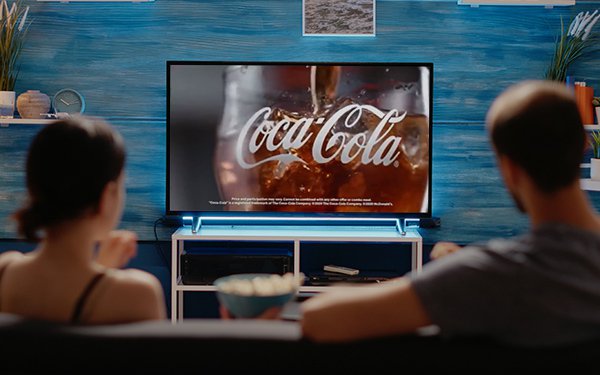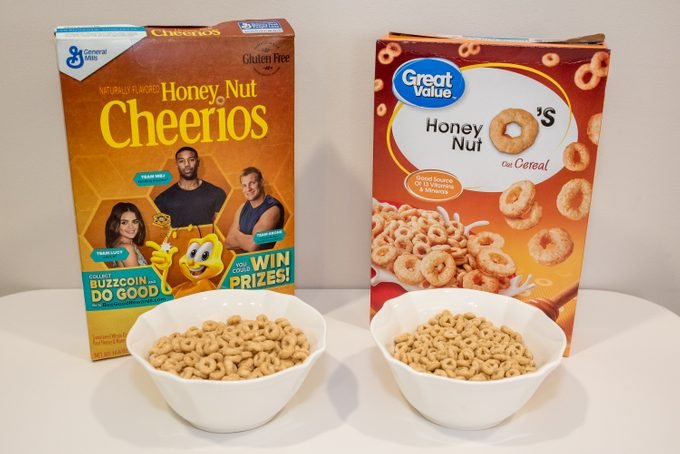Is advertising to kids immoral? Are you wondering how to raise kids who know when they’re being sold something? How can you teach them to take off their rose-colored glasses and see the realities behind ads?
Table of Contents
- Advertising to Kids: It’s a rigged game.
- The Power of Games
- 5 Easy and Fun Family Games Promoting Financial Literacy
- Advertising to Kids: Why It’s Important To Learn This Lesson Early
Advertising to Kids: It’s a rigged game.
On one side are multi-million dollar corporations. They spend hundreds of millions of dollars to figure out consumer weaknesses and then market to our children.
On the other side is us. Mere mortals.
There is a constant tug-of-war in this country between consumers and brands, and it starts when children are born.
Most diaper companies brand their products with adorable little characters.
Did you ever wonder why?
The parents probably don’t care. They simply hope and pray that Minnie can hold in the third blowout that inevitably happens when they take the baby to meet their most uptight aunt.
Is it possible that babies’ brains can start to develop brand affinity before they can figure out how to hold a bottle?
According to the Journal of the American Medical Association (JAMA), children as young as 3 can look at a logo and associate it with a brand.
The only way to level the playing field is to prepare our children for this battle as soon as they can understand they’re playing.
So how do we teach our kids to have smart consumer habits?
One way is to let them experience the disappointment of spending their own money on an item that isn’t what it seems (see the Great Sea Monkey Debacle of ‘85).
Another method comes from the great Mary Poppins. “In every job that must be done, there is an element of fun. You find the fun and snap! The job’s a game.”
The Power of Games
Kids are notoriously resistant to anything that even vaguely resembles work. They don’t like to do things they perceive as “booorrrrrring.”
The older they get, the more they think they know, so at that age even teaching them can become a challenge.
The trick with kids is always teaching them lessons without them knowing. It’s like sneaking vegetables into their smoothies. They absorb all of the good habits and knowledge, but don’t notice or complain along the way.
Kids’ Minds Are Like Sponges
Kids are sponges – they spend their formative years soaking up every ounce of habit (good or bad), knowledge (how quickly can kids learn a bad word?) and behavior (they’re always watching…) that parents model.
In order to stack the deck in their favor, it is vital to teach them good financial lessons early. Gamifying financial lessons can be an excellent way to teach your children how to be savvy consumers.
5 Easy and Fun Family Games Promoting Financial Literacy
Learning about money doesn’t only come in the form of understanding what a mortgage is, the value of compound interest, and how to build a credit score.
Perhaps most importantly it comes in the form of good financial habits that research from Cambridge University (Habit Formation and Learning in Young Children) shows mostly are set by age 7.
One such habit children can learn early is to be discerning and see through the fancy veneer of advertising. And to realize that marketers do target advertising to children.
Not all that glitters is gold, and not every product is actually going to make their lives better.
Impulse buying leads to feelings of regret and frustration, which are bad for mental health. If you can teach your child to resist shiny objects and seek out value, it will benefit both their financial and mental health.
We have put together five easy, fun family games for you to teach your child these lessons without them knowing they’re learning. You don’t have to buy a board game or do endless multiplication flashcards to teach your kids these lessons.
You can just use things you have at home or have to buy anyway to feed your family.
The Commercial Game

This is one of our favorite financial literacy games.
Despite everyone’s best efforts, commercials are here to stay. Even if you have managed to convert to streaming and avoid most of these 30-second sales pitches, chances are every now and again your family watches some programming that includes commercials.
Mute Commercials to Guess What Is Being Sold
Next time your family is gathered around the TV watching their favorite prime-time show or the big game, mute commercials.
First, this is a helpful and easy habit to get into regardless of whether you’re playing a game.
You might have to see, but you don’t have to hear about what they’re selling.
Once the TV has been muted, ask your kids to take turns watching the muted commercials and guessing what they are trying to sell them.
You can either just do one winner per commercial, or adopt a point system: one point per commercial and the person with the most points at the end of the game or show wins.
You can even make it like a game of Jeopardy and let them “buzz” in with answers.
The first one to buzz in with the correct answer is the winner or is awarded the point.
In the beginning, the points will be awarded just for guessing what the advertisement is selling.
As they get better you can ask them what method the advertiser is using to convince them they need the product.
- Do they try to make you feel an affinity towards the brand?
- Scare you into believing you need it?
- Or just the classic method of letting the consumer know they will feel good with their product.
This game teaches kids the simple lesson that commercials are actually trying to sell to them and introduces them to the more complex realities of how they do it.
The Junk Game

No doubt walking into your child’s bedroom is like a minefield of broken toys, just waiting for you to step on one so you can’t walk right for a week.
Next time you and your child are doing a deep clean, get three boxes. Mark them Keep, Give, and Trash.
Start filling the boxes and let your child see how many things she really wants, how many she never uses, and how many are garbage.
In the end, do your best to add up the value of the contents of each box.
Now compare that value to the price of a larger item your child really wants – perhaps a bike or set of legos.
If your child hasn’t been saving for anything, this is a good time to pick a goal.
Ask your child, which do you want more: these boxes of junk or the bike with 10 gears.
Curbing Impulse Buying
Now, going forward, whenever your child asks for an impulse item you’re inclined to buy, offer to instead add it to their savings account for that bike.
Keep a visible tally for them to see. They will get the instant gratification of adding money into their savings, and the delayed gratification of the larger prize at the end.
This is a lesson a lot of adults can still find value in. As we look around our homes, we frequently find the products of impulse buying decisions.
It seemed SO necessary in the store, but once the item is home it lost its shine.
Store aisles are lined with these sirens – calling on us to purchase (and then regret).
They’re always packaged beautifully and priced just right, but ultimately they don’t typically add value to our lives.
If you play the Junk Game with your children, and then they watch you resist the impulse buys, they will be well on their way to doing the same as adults.
This will save them hundreds of dollars a month, but perhaps even more importantly, those unfortunate feelings of frustration and regret.
The Reality Game

Companies sell us things by convincing us they will make our lives better. There is usually some truth to this, but at the end of the day, a vacuum is just a vacuum.
There is a gap between what we are sold and what we end up with at home.
As you go about your daily activities, ask yourself how many things were just supposed to work better or do more.
- The car that was supposed to respond to voice commands but can never seem to understand you.
- The TV that was supposed to be smart but got dumb when new technology came out 6 months later.
- The vitamins that were supposed to make your skin glow, but really just make your face shine.
You can help your child avoid these same mistakes by showing them early that what they’re being sold frequently doesn’t match what they take home.
How to Play the Reality Game
This game only requires items you have at home and access to YouTube.
- Find a big-ticket item, such as your vehicle or an expensive toy.
- Next, look on YouTube for an advertisement about that particular product. There are usually several. Especially if it’s a vehicle. Make sure to find an advertisement and not an independent product review.
- Watch the video a few times with your children. Spend some time letting them examine or play with the item.
- Now, go around and have each child point out the differences between the advertisement and the actual object.
Scoring in the Reality Game
Award one point for every true difference (ours is a different color doesn’t matter, but the minivan entertainment system never works quite right is legit).
This is a fun game to teach kids that things are not always what they appear to be in advertising.
If you grew up with Calvin and Hobbs, you might remember Calvin’s heroic efforts to eat enough breakfast cereal to get the beanie with the little helicopter propeller on top. Calvin’s excitement quickly turned into horrible disappointment when the beanie arrived and Calvin discovered that it didn’t make him fly.
It’s a good lesson to learn before you eat 25 boxes of Chocolate Frosted Sugar Bombs to get the prize. It seems like cartoons and comics used to teach those lessons, but that has since been replaced by endless product placement.
And that brings us to another opportunity for a game…
The Product Placement Game

This one requires almost no work on your part. All you need is a pencil and paper for your child.
First, you’ll need to give them a brief explainer on product placement in shows and movies.
“Look Timmy, your favorite character doesn’t just love Wheaties because they’re delicious. They love Wheaties because Wheaties pays your favorite character handsomely to eat them when he’s making the show.”
This explanation in and of itself might be eye-opening to your child who thought that Rapunzel had a true affinity to a certain brand of comb.
Then, the next time your kids sit down for movie night, give them each a pad of paper and a pencil. Ask them to watch the movie or show with a more critical eye and write down every instance of product placement they happen to see.
This is a fun game because the first time you play it, kids often only note the very obvious products. However, once they have played multiple times they will start to notice the more subtle advertising which targets children and their little minds.
The Brand Game

Image courtesy of tasteofhome.com.
Almost everyone has a finite amount of money to spend. This is why it’s crucial to learn how to make and stay on a sensible budget. (See 50/30/20 Budgeting article).
Even kids can learn to set and stick to a budget. This will help them immensely later in life.
One of the ways to stay on budget is with off-brand or generic products. But, as discussed earlier, brands start targeting kids at a very early age.
Chances are, your child has already developed brand affinity, and maybe even brand loyalty, to certain products.
It is valuable early in life to test these affinities and loyalties to help make your child a smart shopper. This is a fun game that does just that.
How the Brand Game Works
- Buy two versions of a few products your child likes – it could be anything from breakfast cereal to toothpaste.
- Next, do blind tests for your child with the two brands to show them that there is really very little noticeable difference.
- Finally, discuss the price difference and how buying generic items could help keep a family on budget.
Another way to demonstrate this value proposition is to just start buying the generic brand of something your family uses. Cheerios is an easy one, since so many stores have some store-brand version of this popular cereal.
Just putting the store brand out in the morning and casually mentioning the switch (after they either haven’t noticed or cared) is a great way to subtly teach a valuable lesson.
Advertising to Kids: Why It’s Important To Learn This Lesson Early
As we said previously, the 2013 study from Cambridge University discovered that adult money habits are basically formed by age 7.
The good news is that kids are soaking up these values during those critical years where they view their parents as superheroes who can do no wrong.
Later, when our angels turn to teens, and we can do nothing but wrong, hopefully they’ve already learned much of what we have to teach. These little lessons about consumerism and value will stick with your kids as they grow into adults and help them make decisions about how and where to spend their money.
The best way to avoid your teens and young adults having to learn everything the hard way, is to teach them early before they even know they’re learning. Lessons of savvy consumerism will stay with them and help them make good spending decisions the rest of their lives.
This will lead to increased financial and mental health, and happier people all around.
